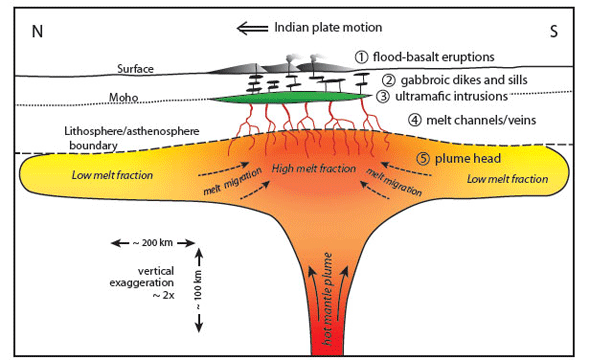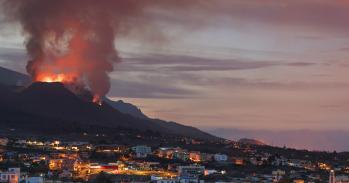
The asteroid that slammed into the ocean off Mexico 66 million years ago and killed off the dinosaurs probably rang the Earth like a bell, triggering volcanic eruptions around the globe, according to a multi-disciplinary team of scientists.
The asteroid that slammed into the ocean off Mexico 66 million years ago and killed off the dinosaurs probably rang the Earth like a bell, triggering volcanic eruptions around the globe, according to a multi-disciplinary team of scientists.
If you try to explain why the largest impact we know of in the last billion years happened within 100,000 years of these massive lava flows at Deccan … the chances of that occurring at random are minuscule
Mark Richards, University of California Berkeley
The team of researchers, which included Dr Sally Gibson from Cambridge University’s Department of Earth Sciences, argue that the impact may have triggered most of the immense eruptions of lava in India known as the Deccan Traps. In a paper published in The Geological Society of America Bulletin they claim this would explain the “uncomfortably close” coincidence between the Deccan Traps eruptions and the impact, which has always cast doubt on the theory that the asteroid was the sole cause of the end-Cretaceous mass extinction.
The Deccan Traps are a vast accumulation of igneous rock, and one of the largest volcanic features on Earth, located on the Deccan Plateau in India. Formed by huge lava flows, they cover an area of approximately 500,000km2 and stretch across the Indian subcontinent from Mumbai to Kolkata.
“If you try to explain why the largest impact we know of in the last billion years happened within 100,000 years of these massive lava flows at Deccan … the chances of that occurring at random are minuscule,” said team leader Mark Richards, Professor of Earth and Planetary Science at the University of California, Berkeley. “It’s not a very credible coincidence.”
While the Deccan lava flows, which started before the impact but erupted for several hundred thousand years after, probably spewed immense amounts of carbon dioxide and other noxious, climate-modifying gases into the atmosphere, it’s still unclear if this contributed to the demise of most of life on Earth at the end of the Age of Dinosaurs. “This connection between the impact and the Deccan lava flows is a great story and might even be true, but it doesn’t yet take us closer to understanding what actually killed the dinosaurs,” Richards added.
The disappearance of the landscape-dominating dinosaurs is widely credited with ushering in the age of mammals, eventually including humans.

“Paul Renne’s group at Berkeley showed years ago that the Central Atlantic Magmatic Province is associated with the mass extinction at the Triassic/Jurassic boundary 200 million years ago, and the Siberian Traps are associated with the end-Permian extinction 250 million years ago, and now we also know that a big volcanic eruption in China called the Emeishan Traps is associated with the end-Guadalupian extinction 260 million years ago,” Richards said.
“Then you have the Deccan eruptions – including the largest mapped lava flows on Earth – occurring 66 million years ago coincident with the mass extinction of the dinosaurs. So what really happened?”
Richards teamed up with a multi-disciplinary group of experts to try to discover faults with his idea that the impact off the coast of Mexico triggered the Deccan eruptions, but instead came up with supporting evidence. Paul Renne, a Professor in Residence in the University of California, Berkeley’s Department of Earth and Planetary Science and Director of the Berkeley Geochronology Center, re-dated the asteroid impact and mass extinction two years ago and found them essentially simultaneous. He also found they were within approximately 100,000 years of the largest Deccan eruptions, referred to as the Wai subgroup flows, which produced about 70 percent of the lavas that now stretch across the Indian subcontinent.
Richards and his team found pronounced weathering surfaces marking the onset of the huge Wai subgroup flows, which may indicate a period of inactivity in Deccan volcanism prior to the asteroid impact. Since the team’s manuscript was accepted for publication, new radioisotopic ages published by scientists at Princeton University and preliminary ages from the Berkeley group have confirmed that the Wai lava flows closely postdate the asteroid impact.
“This was an existing massive volcanic system that had been there probably several million years, and the impact gave this thing a shake and it mobilised a huge amount of magma over a short amount of time,” Richards said.
“Based on the distances between erupting volcanoes and the epicentres of earthquakes, a large asteroid impact in Mexico could generate a huge earthquake (equivalent to magnitude 9 or greater) that would have enough seismic energy to shake magma chambers deep in the Earth below the Deccan and cause a sudden massive outpouring of lava, 100,000 years or so after the impact event itself,” explains Gibson.
“Our findings have broad implications for studies of past climate change, evolutionary biology, and how earthquakes might trigger volcanic eruptions.”
Inset image: Cross-sectional diagram to schematically illustrate the Deccan plume melting in the mantle beneath the Indian subcontinent 60 million years ago (from Richards et al., 2015)
Article originally published by the University of California, Berkeley

The text in this work is licensed under a Creative Commons Attribution 4.0 International License. For image use please see separate credits above.




